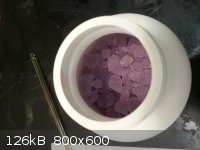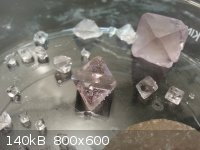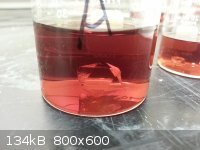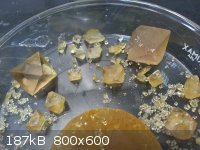| Pages:
1
2 |
MrHomeScientist
International Hazard
    
Posts: 1806
Registered: 24-10-2010
Location: Flerovium
Member Is Offline
Mood: No Mood
|
|
Got some photos of my crystals for your viewing pleasure!
My ferric ammonium sulfate was purchased from Sigma Aldrich something like 15 years ago. It appears in the bottle as lavender chunks. (Photo 1)
I dissolved some in water as detailed in my post above back in October and left it in the fume hood to see what it would do. Just last week I checked
on it and gorgeous large crystals had grown! I harvested the largest from the liquor and some were very well formed. The largest was unfortunately
plagued with lots of parasitic small crystals. (Photo 2)
I placed three of the better formed crystals back in the solution to continue growth. You can see the rich brown color of the solution, completely
clear with no iron hydrolysis evident. We'll see how it goes! (Photo 3)
  
|
|
|
blogfast25
International Hazard
    
Posts: 10562
Registered: 3-2-2008
Location: Neverland
Member Is Offline
Mood: No Mood
|
|
Very nice indeed, MrHS.
Years ago I read that growers of really macro crystals (of alums), like 2" or more, actually cheat by gently filing (or sanding) off the parasitic
ones! Sound plausible to me: once a crystal fault line has developed there's no cure, well... other than filing off the side growth.
Re. hydrolysis, the brown colour is due to Fe(OH)<sup>2+</sup>, which would be the first step to Fe(OH)<sub>3</sub>. But here
acidity and concentration of Fe(III) prevent it from going all the way.
[Edited on 13-12-2013 by blogfast25]
|
|
|
DraconicAcid
International Hazard
    
Posts: 4421
Registered: 1-2-2013
Location: The tiniest college campus ever....
Member Is Offline
Mood: Semi-victorious.
|
|
Impressive. I can never get nice crystals like that, even from something as simple as alum.
Please remember: "Filtrate" is not a verb.
Write up your lab reports the way your instructor wants them, not the way your ex-instructor wants them.
|
|
|
MrHomeScientist
International Hazard
    
Posts: 1806
Registered: 24-10-2010
Location: Flerovium
Member Is Offline
Mood: No Mood
|
|
Thanks! I had actually forgotten about them for a while, growing in the back of the hood. Apparently it's the perfect environment for slow crystal
growth!
Thinking about it this weekend, I had an idea: What about growing my large crystal on a teflon stage? I.e. put a disk of teflon in the beaker that the
large crystal will sit on. Would teflon resist formation of new crystals?
If not teflon, what about a hydrophobic surface? I have some Never Wet that I've been playing with. If the solution can't get to the surface, maybe
that would prevent new crystals from growing.
Any other ideas to prevent these little crystals from growing where I don't want them?
|
|
|
Poppy
Hazard to Others
  
Posts: 294
Registered: 3-11-2011
Member Is Offline
Mood: † chemical zombie
|
|
Mr Home Scientist, I think those big crystals are nothing but a chunk of ammonium sulphate that has went out separately!
You can compare sizes and color or even redissolve those if you please and tell us if anything might have ended bad again!
|
|
|
blogfast25
International Hazard
    
Posts: 10562
Registered: 3-2-2008
Location: Neverland
Member Is Offline
Mood: No Mood
|
|
Quote: Originally posted by Poppy  | Mr Home Scientist, I think those big crystals are nothing but a chunk of ammonium sulphate that has went out separately!
You can compare sizes and color or even redissolve those if you please and tell us if anything might have ended bad again! |
Utter nonsense. If you start from ferric ammonium alum you end up with ferric ammonium alum.
|
|
|
blogfast25
International Hazard
    
Posts: 10562
Registered: 3-2-2008
Location: Neverland
Member Is Offline
Mood: No Mood
|
|
Quote: Originally posted by MrHomeScientist  | Thinking about it this weekend, I had an idea: What about growing my large crystal on a teflon stage? I.e. put a disk of teflon in the beaker that the
large crystal will sit on. Would teflon resist formation of new crystals?
If not teflon, what about a hydrophobic surface? I have some Never Wet that I've been playing with. If the solution can't get to the surface, maybe
that would prevent new crystals from growing.
|
I don't really see how sitting them on a hydrophobic surface would prevent solution from getting to the [crystal] surface. Even if you did achieve the
latter, you wouldn't get any crystal growth at all there.
|
|
|
MrHomeScientist
International Hazard
    
Posts: 1806
Registered: 24-10-2010
Location: Flerovium
Member Is Offline
Mood: No Mood
|
|
Quote: Originally posted by blogfast25  | | I don't really see how sitting them on a hydrophobic surface would prevent solution from getting to the [crystal] surface. Even if you did achieve the
latter, you wouldn't get any crystal growth at all there. |
Well that's the idea though. Place a hydrophobic or teflon surface in a beaker, place one of my large crystals on that, and fill the beaker with
ferric alum solution. This way the large crystal will grow, but no small crystals will start growing elsewhere on the surface since there'd be no
other nucleation sites. That's the thought, at least.
|
|
|
blogfast25
International Hazard
    
Posts: 10562
Registered: 3-2-2008
Location: Neverland
Member Is Offline
Mood: No Mood
|
|
Hydrophobic really means 'high surface tension' but even the highest surface tension is overcome by modest hydrostatic pressure, for instance a Teflon
beaker still fills with water.
I personally don't see how a hydrophobic resting surface for the crystals could prevent side growths.
How about weightlessness? All these balls of ferric ammonium sulphate solution with crystals in them, floating about in a space station? The sky is
the limit, no? 
[Edited on 17-12-2013 by blogfast25]
|
|
|
MrHomeScientist
International Hazard
    
Posts: 1806
Registered: 24-10-2010
Location: Flerovium
Member Is Offline
Mood: No Mood
|
|
I see, thanks for the responses.
If anyone knows of any methods to prevent these extra crystals from growing I'd be interested to hear about them. Space station would be ideal!
Barring that, I know some people suspend the crystal in the solution to avoid parasitic growths. But I can't think of how to do that without ruining
the formation process around whatever string holds it up, and then trapping the string inside the crystal for all to see. I'd think even fishing line
would be visible, unless it happens to match the material's index of refraction perfectly.
|
|
|
Poppy
Hazard to Others
  
Posts: 294
Registered: 3-11-2011
Member Is Offline
Mood: † chemical zombie
|
|
Quote: Originally posted by blogfast25  | Quote: Originally posted by Poppy  | Mr Home Scientist, I think those big crystals are nothing but a chunk of ammonium sulphate that has went out separately!
You can compare sizes and color or even redissolve those if you please and tell us if anything might have ended bad again! |
Utter nonsense. If you start from ferric ammonium alum you end up with ferric ammonium alum. |
I just don't know but my method yielded much purplish samples, so how about no?
|
|
|
blogfast25
International Hazard
    
Posts: 10562
Registered: 3-2-2008
Location: Neverland
Member Is Offline
Mood: No Mood
|
|
Poppy:
We know ferric ammonium alum comes in two colour variants but we don't really know why (it's been discussed elsewhere here). The colourless crystals
in MrHS sample are FAA too, not ammonium sulphate.
[Edited on 20-12-2013 by blogfast25]
|
|
|
MrHomeScientist
International Hazard
    
Posts: 1806
Registered: 24-10-2010
Location: Flerovium
Member Is Offline
Mood: No Mood
|
|
Update
I took my crystals out of the growing solution Friday of last week, since I wouldn't be around to check on them over the weekend. I returned Wednesday
and found they had discolored - turning significantly brown!

I put the nicer, large crystals back into solution and covered the beakers with Parafilm. I didn't want any more growth, I just wanted to see if
"rehydrating" them would solve the problem. To my relief, it did. Two days later, my large crystals have returned to their previous transparent
lavender color. Had me worried for a minute there! I wasn't aware these crystals would be air-sensitive.
|
|
|
blogfast25
International Hazard
    
Posts: 10562
Registered: 3-2-2008
Location: Neverland
Member Is Offline
Mood: No Mood
|
|
Years ago I saw a sample of a large FAA crystal (about 2"), in a museum. Years of exposure to dry air had eroded the surface considerably, even though
it had been varnished to prevent that!
Just keep your samples in a closed container and they should preserve indefinitely.
|
|
|
rey31tjia
Harmless

Posts: 1
Registered: 31-10-2017
Member Is Offline
Mood: No Mood
|
|
Quote: Originally posted by kmno4  | Yes, I confirm this procedure. FeSO4 + H2SO4 + H2O2 + (NH4 )2SO4 really works fine.
I used to make larger amount ( ~ 200g) of this alun.
Indeed, from deep brown solution small white crystals are formed.
On the picture - mentioned alun.
It is almost coloreless, with a little amethyst (~violet) shade.
ps. my fellow made (in similar way) beautiful, large (> 1 cm), bright violet crystals of Fe(III) sulfate ( x 9 H2O).
ps2. with aid of ~5% acidic solution of K3[Fe(CN)6] you can test presence of Fe(II) in your oxidated solution. When Fe(II) ions are present, deep blue
colour/precipitate appears when you mix ferricyanide sol. with tested sol. It is very sensitive test. When only Fe(III) ions are present, mixing gives
clean brown solution.
[Edited on 8-9-2008 by kmno4] |
How did you crystallize it? Did you refrigerate the solution? Please help me..
Thank you..
|
|
|
jamit
Hazard to Others
  
Posts: 375
Registered: 18-6-2010
Location: Midwest USA
Member Is Offline
Mood: No Mood
|
|
so I followed the synthesis of blogfast25 and I obtain violet crystals but they oxidize so quickly to light brown with in 10 hrs and they are sticky?
did i do something wrong? has anyone also had this problem making ferric alum.
I dissolved ferrous sulfate and acidified it with sulfuric acid. Then I oxidized it with peroxide until the effervescence ceased. I then added
solution of ammonium sulfate and mixed the two solutions together.
Then I filtered and heating to remove some liquid and allowed it to evaporate until lilac crystals form. but the ferric alum oxidizes back to light
brown color within 6-10 hrs while drying and they are really sticky. help!!
|
|
|
Fery
International Hazard
    
Posts: 1055
Registered: 27-8-2019
Location: Czechoslovakia
Member Is Offline
|
|
jamit you did very nice experiment
I did the same as you did
I remember that I used slight excess of H2SO4
I think the color change into orange it is not any oxidation, but it is losing of crystalline water or absorbing air moisture
pure crystals are almost colorless, very very very pale violet, I have a vial with them which I synthesized 30 years ago and they are still good
quality (but the cap is also sealed with wide rubber band)
water solution and crystals with lost crystalline water have orange color
very interesting how almost colorless crystals are formed from such orange colored solution
|
|
|
Bedlasky
International Hazard
    
Posts: 1251
Registered: 15-4-2019
Location: Period 5, group 6
Member Is Offline
Mood: Volatile
|
|
Jamit: The colour change is due to loss of water, not due to oxidation. Ammonium ferric sulfate is violet because it contains violet [Fe(H2O)6]3+ ions
in it's crystalline structure. If some water is lost, sulfate coordinates on to Fe(III) an these complexes are brown in colour.
To prevent water loss, you can store crystal in saturated solution of ammonium ferric sulfate or in the paraffin oil. I keep mine in paraffin oil and
it is still violet after several years. It doesn't look exactly like freshly crystallized crystal, it's paler, but it is still well preserved.
For crystal growing tips, this site is quite useful.
https://en.crystalls.info/Iron(III)-ammonium_sulfate
|
|
|
| Pages:
1
2 |